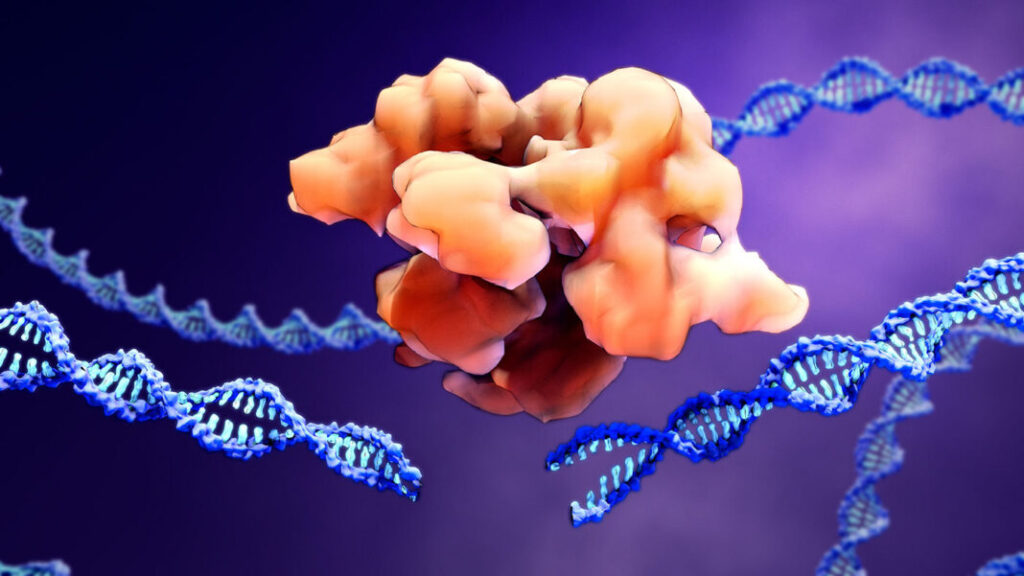Development of bespoke therapies has been a driving goal in medical research. This year, the announcement of the first patient treated with personalized CRISPR therapy, Baby KJ, highlights this achievable goal. Baby KJ was born with a rare genetic metabolic disorder that may have led to neurological damage or death. His treatment with a personalized CRISPR therapy changed the expected outcome drastically and is a prime example of how similar therapies may be used for other patients.
A multitude of devastating illnesses may potentially be treated using tools like CRISPR and base editing, including vascular diseases. Multisystemic smooth muscle dysfunction syndrome (MSMDS) is a rare disease that can lead to stroke, aortic dissection, and even death in young children. The most common cause of the disease is a single mutation in the ACTA2 gene.
Editing ACTA2 with CRISPR-Cas9 has the potential for developing a therapy for MSMDS, a disease that currently has no effective treatment or cure. However, researchers at Mass General Brigham found that in correcting the mutation using conventional Cas9 proteins, other regions of the DNA were also changed, resulting in an ineffective treatment.
The team, led by Patty Musolino, MD, PhD, a researcher in the department of neurology at Massachusetts General Hospital (MGH), engineered and screened dozens of configurations of base editors to precisely target the single mutation without further editing other portions of the DNA. They then tested their candidates in a mouse model for MSMDS using an AAV vector. Treatment with the bespoke CRISPR-Cas9 showed increased survival in MSMDS mice and reduced MSMDS phenotypes in the vasculature, aorta, and brain.
Published in Nature Biomedical Engineering, their paper is entitled, “Treatment of a severe vascular disease using a bespoke CRISPR–Cas9 base editor in mice.”
GEN spoke with Musolino and coauthor Ben Kleinstiver, PhD, an investigator in the Center for Genomic Medicine at MGH and founding member of the Mass General Brigham healthcare system, about their work.
This interview has been edited for length and clarity.
GEN: What led your team to begin this project?
Musolino: A few years ago, a patient who was two years old at the time came into our clinic. Though she was so young, she had already been through so much, including a surgery at two weeks old, ongoing issues with her gut and bladder, brain injury, and seizures. After reviewing her vessels and some initial testing, we found the ACTA2 variant, and we knew she had MSMDS. We realized that we could do in our labs what was needed to understand the mechanisms and develop targeted therapies.
Kleinstiver: We wondered what gene editing approaches could be used to try to alleviate the devastating symptoms. We considered many different editing approaches and tested several initially, with base editing emerging quickly as an efficacious and precise method to correct the underlying genetic mutation in the ACTA2 gene.
GEN: What challenges did you face while developing a more precise base editor against ACTA2?
Kleinstiver: In initial experiments we found that although we could use a conventional adenine base editor (ABE) comprised of wildtype SpCas9 to make the intended edit, this corrective edit was also accompanied by the concurrent editing of another nearby adenine, resulting in a ‘bystander edit.’ We performed experiments to determine the impact of the non-synonymous bystander edit, which revealed that the bystander edit led to a deleterious phenotype and should be avoided, otherwise there’s limited benefit from the on-target correction.
To overcome this challenge, we screened other ABEs comprised of a PAM variant Cas9 enzyme called SpCas9-VRQR that can recognize sites with NGAN protospacer-adjacent motifs (PAMs) compared to NGG for wildtype SpCas9, which then allowed us to shift the ‘edit window’ of the base editor to mitigate bystander editing while still preserving on-target editing. This simple shift of the target site enables a drastic improvement in the precision of on-target editing.
To improve the efficiency of on-target correction with SpCas9-VRQR ABEs, we then tested various activity-enhancing mutations in SpCas9, where some of these mutations were from our own prior research and from that of others, and some mutations were novel.
Notably, when using the ACTA2 mutant sequence as the DNA substrate for engineering, we identified several additional amino acid substitutions that improved the efficiency of SpCas9-VRQR. The screening of the library of SpCas9-VRQR mutants against the actual target site demonstrates that bespoke enzymes can be developed when using the mutant sequence as the query.
GEN: Was there a particular moment in this study that stood out to you?
Kleinstiver: At the time that we generated these first datasets a few years ago, avoiding bystander editing through the use of PAM variant Cas9 enzymes in the base editor was really quite exciting to me as this hadn’t really been done before. Furthermore, using the actual target site as the engineering substrate to develop a more efficacious enzyme is a unique feature of this work, making the engineering a little more patient-focused.
GEN: The customized base editor works well in the pre-clinical mouse model; what challenges do you foresee in bringing this therapy to patients? How close are you to bringing this to the clinic?
Musolino: The steps that allow a preclinical proof of concept study, like this one, to become a first-in-human therapeutic include an FDA INTERACT meeting, and a pre-IND—both of which we have completed.
We have also secured FDA rare disease designations including Orphan Drug Designation, which are milestones that will accelerate development. There are additional toxicology studies that need to be done as part of the FDA next steps, and we are hopeful that we will be in first-in-human in 2027.
GEN: What are you looking forward to in the next steps?
Kleinstiver: Our study, alongside the recent editing approach to treat CPS1 deficiency (UPenn, NEJM 2025 for Baby KJ) proves the concept that bespoke editors can be developed and rapidly deployed to treat human disease.
The next steps include finding ways to broaden the applicability of this blueprint by (a) streamlining the nomination of optimal base editors and gRNAs, (b) expediting the assessment of on- and off-target editing, (c) overcoming financial and time bottlenecks in manufacturing, and (d) motivating new regulatory frameworks that will enhance the extensibility of these approaches to additional mutations or genes across the same disease in the initial IND application.
Together, success of these next steps will permit more generalizable development and application of bespoke genome editing approaches to treat more patients.



